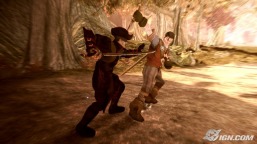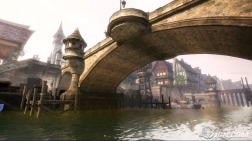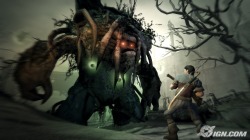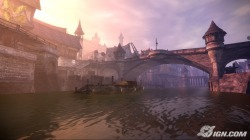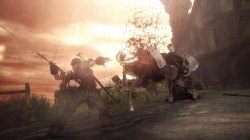The Art of Fable 2
Fable 2 is so close, you can almost taste it. After what seemed like endless delays and date slips, the first game won the hearts of many with its charming presentation, surprisingly open world and the ability to be a bisexual bigamist who sacrificed innocent villagers. At least that's how we played it.
So with a far more controlled development schedule and a vastly more powerful console at its disposal, it's no wonder we're a bit excited about Fable 2. For the team behind it, though, it's been a remarkable challenge and a labour of love, and a few weeks ago we got to sit down with two of the men most directly responsible for the game's unique look - technical art director Ian Lovett, and lead concept artist Mike McCarthy - for a frank chat about art, technology and sleepless nights.
And this may also be about the only Fable interview you read which doesn't even mention the bloody dog, so savour it.
Eurogamer: You moved straight from Fable on the Xbox to Fable 2 on the 360. What was it like taking a visual style developed for one generation of hardware and trying to make it work on the next?
Ian Lovett: We looked back at what was good about Fable - that's the first thing you do. I always felt that Fable was about these incredible, lush, green environments, and about really quirky characters. Not necessarily the most beautifully realised characters - but there was lots of personality there. It had a certain atmosphere to it that we wanted to recreate.
Once we had our pillars, our visual pillars, then we sat down and talked about how we wanted to re-imagine it. We did a horribly wanky thing, actually, which is that we came up with a visual mission statement. Although it's awful, nasty, business yuck, what it helped us do was to concentrate our thinking into how we'd really describe it. Secondly, it helped us to sell it up the chain. You know, Microsoft weren't just going to rock up with a fat chequebook of X million, or whatever, and say "hey guys, go ahead, we're going to take a punt on you despite the fact that you were years late with Fable - do another one for us!"
What we decided was that we wanted Fable 2 to be like Fable, but done by Ridley Scott. That was our mission statement. The idea behind that is that Microsoft understand Ridley Scott, they understand that this means that we wanted to mature the franchise a little bit. Not losing its charm, but basically trying to grow it up ever so slightly. I think that fits in very well with the jump from Xbox to 360. It's not that it's a change in audience - it's just a new layer of sophistication.
Oh, and we made the feet smaller.
Mike McCarthy: Yeah, we made the feet and the hands smaller. We brought in the proportions of everything, so it isn't quite as cartoony - a slight movement towards reality. We do know that whenever you do that with a successful product, you've got to be aware that this is the stuff that people like about it, so you've got to keep that in mind.
Ian Lovett: Look what happened to the Diablo guys!
Mike McCarthy: Yeah, exactly. You've got to keep what's good about it - but we did want it to be darker, and moodier.
Ian Lovett: It's interesting, you know. Fable made Microsoft a lot of money, and with that comes a tremendous amount of responsibility, because it's "yeah, brilliant, a Franchise! Grab that bad boy!" They come back to the same team who made it, because hopefully there's a good chance that they'll do a reasonable job of it.
Eurogamer: A reasonable job, and a little bit quicker?
Ian Lovett: Oh, we had good production this time! [Laughs] Somebody cracking the whip!
Mike McCarthy: After about every sixteen minutes, you'd be asked, "Is it done? Is that done? Is it done yet? Now? Is it done?"
Ian Lovett: The scariest thing was, though, that it's a tremendous amount of faith on Microsoft's behalf. We decided that we weren't going to use a middleware engine. We looked at Unreal - and it's an amazing engine, don't get me wrong. We've got nothing against it. But it wasn't what we needed for Fable, so we said, let's go and develop another engine.
Of course, that means that for the first two years of development, you're not going to see anything. All you're going to see is concepts, a couple of tests... The amount of faith which that takes when you've got a franchise which, in Microsoft's eyes, is number two only to Halo, and the money that goes with that. That's a tremendous punt to take on a bunch of people.
So, we had to spend quite a bit of time selling the fact that this was going to look the way we said it would, that we were going to be able to re-imagine this in an appropriate way for the 360 - bringing all of these disparate elements in, and doing it in a shorter time, with a bigger team and all the challenges that come with that. It was really challenging - but we had a brilliant team.
Mike McCarthy: I think that in the 3D part, actually doing the characters and doing the environments and stuff, all we could do really was ask the teams to build stuff how they thought it should look in the game. They built it, textured it and lit it - and then there was a huge transition between "right, that's how we want it to look" and "can we get the engine to make it look that way?"
Ian Lovett: The only reason we've done it quicker this time is because we cut the slack and the waste. We whiteboxed everything before we built it this time. In Fable 1, we were dicking around with the design all the way through - we didn't know how big a house had to be until we'd already made some models! This time we used sketch art and whiteboxed out things, so we knew that when we built things, they were roughly the right size.
We didn't cut anything out to finish the game in a shorter timeframe. We were just a lot more efficient.
Eurogamer: When you talk about developing an engine, and spending two years building art without an engine to throw it into... Was there a day that came where you brought the two things together, and everyone just bit their nails and prayed it would work?
Ian Lovett: Yeah, it's really... It's a massive leap of faith. But we learned a lot from Fable 1. By and large, we're all pretty experienced developers. We have a very senior-heavy team - most of the guys are all Fable 1 people, or they come from years in the industry.
Yeah, there's an amount of nail-biting... But with that, there sort of comes the breadth of experience which says, "yes, you're going to be terrified, we're going to have crisis talks, but we're going to come through it."
Mike McCarthy: I think it's also a lot more gradual than you might think. What you do is, you go through iterations of what's wrong. Initially, everything is wrong! You put the art in there, and everything is wrong. So, okay, we fix everything. Then in the next iteration, it's sort-of everything, but not quite.
Ian Lovett: We're a real iteration-style company. We build that into our development. We do things the first time, not to a final standard, because we know that we're going to come back to it and re-polish it. Some of that is to build in some slack against design changes and stuff, other parts are so that early objects get to mature as the style comes together.
I think, well, we've tried to be tremendously clever - we've made a lot of mistakes, but we have tried our best to be as smart about developing this as possible. When you consider the size of the game, the time that we had, the platform shift, the new engine, the new tools... And Peter [laughs]... I think we did a straight-up job there!
I'm quite pleased how it came together. Although, of course, when you're that close to a game for that long - I can't look at it now without seeing all of the bugs, all of the problems, all of the things that went wrong.
Mike McCarthy: I think the coolest thing about it, actually, is when you get to this stage of the project - after it's mostly done. In your own way, you're almost as surprised by it as everyone else is. When I see footage of other people playing the game, I think, wow - it's a proper game! It's only at the last minute that everything comes together.
Ian Lovett: The last 500 bugs are the ones that stop it looking good. They're the last ones we fix, and you're sitting there going, "please god let the lighting fall into place", "please god stop the trees from being black" - or flat, or something. Every game is like that, but the level of expectation on a reasonably successful franchise means that there are a lot of critical eyes pointed in your direction.
I've forgotten what question we were answering, actually.
Eurogamer: I have no idea what I asked - it was a very long time ago.
Ian Lovett: It was a great question, though.
Eurogamer: Thanks. Okay - say I'm a consumer, I come along and buy Fable 2. What are the things that are really going to jump out at me in terms of the art? What are the really big changes, or really big features that make the game unique?
Mike McCarthy: By comparison with the first game, it's much more detailed.
Ian Lovett: Yeah - there's a layer of fidelity that you didn't see in the first one. For all that I felt that the first game was quite rich in a number of ways, it was very primitive. A lot of things were very roughly realised. We didn't have the texture space or the memory to do things the way that we wanted to. For a consumer... Well, that's a really difficult one, actually, because by and large - you're going to hate me for this - by and large, consumers are visually illiterate. They don't understand what they're looking at.
Mike McCarthy: Do you really want to say that?
Ian Lovett: Yeah! Yeah, I do actually.
Mike McCarthy: So what you're saying is, by and large, our audience are morons, and...
Ian Lovett: No, no! It's just... They're not necessarily going to notice. I want them to be drawn in, and that's more than the sum of the parts. Nobody's going to look at this and go, "what amazing normal mapping on that! I'm so glad they did that!"
Eurogamer: I guess I was driving less at the technical side of the art, and more at the traditional side - what's different about the look and style of the game.
Ian Lovett: Okay. Well, one of the key things that's going to bring the whole thing alive is that the lighting is very good. That works particularly well. Everything looks much more grounded and solid, like part of the world. You walk under the trees and you get a green glow coming in.
I mean, that's all great technology - but hopefully that's invisible to the consumer. He'll just look at that and feel like he's in a forest. You'll feel more part of the game, more wrapped up in the experience.
I also think that this game is a bit more consistent, actually. In the first one, there were definitely some things that didn't quite match with other things, and what have you. On this one, John [McCormack, art director on the game] has done an amazing job of whipping the art team into a very consistent type of style. Everything hangs together with a much more convincing look.
That's one of the things Nintendo always do. Everything is so solid - it really feels like it's part of their world. Nothing feels out of place.
Mike McCarthy: I think that's it, that's the challenge. It's when people don't notice it that it's successful. When nothing jumps out at them as not belonging in that universe.
Ian Lovett: We want them to be sucked into the game and the story, and we want it to be fun.
Mike McCarthy: We want it to be immersive, and when it's totally immersive, you don't question. You don't go around thinking, "well, that doesn't look like it belongs", or "that bit looks really realistic".
Ian Lovett: That's the analogy with Toy Story. That could have been a graphical showcase - and the fact that it's beautiful is neither here nor there. The reason people went to see that film is because it was a really, really good story and film. Now, I'm not saying that Fable's story is quite on that level, but it's playing to a number of different strengths.
That's what we want. We want the art to be complementary to the experience. It should be light-hearted and humorous, where the game is. It should poke fun at things... We're not really talking a lot about the animation, but that's probably one of the areas that really brings the game to life. The art is the backdrop, the animation is the personality - and the story on top is the reason that you're there.
Mike McCarthy: I think generally, in a funny way, it's very slightly more realistic than Fable. The look of it is slightly... Fable is really quite cartoony. This is slightly less exaggerated. It's still not trying to be real life.
Ian Lovett: It's stronger for it. We always said that it was a kind of exaggerated stereotype. If something needed to be big and bold, it wasn't afraid of pushing the boundaries to do that. We still do that in Fable 2, but we just toned everything down slightly.
Eurogamer: Was there anything that you really wanted to do in Fable 1 - from an artistic, or area design perspective - which Fable 2 has now given you the freedom to do?
Ian Lovett: Oh god, all kinds of things. Oh, hell yeah. The possibilities suddenly go whoosh!
Mike McCarthy: Just the amount of detail you can get into everything...
Ian Lovett: The thing is, you are overwhelmed initially - partly because we felt very constrained at the end of the Xbox lifespan. It was a great platform, but when you've been working for that long on one platform, you're like, "please, god, just let me have a few more polygons!"
We made a real decision that, whilst we were going to increase the quality - the polygons, the textures - involved in making the world, really what we wanted to do was make the world bigger. More people. More houses. Rather than keeping it the same size as Fable, and having super-beautiful one-off houses here and there, we were going to do twenty houses instead.
That means that there wasn't necessarily the same jump as some other games that have gone from Xbox to 360, or from PS2 to - eventually! - the PS3. We wanted to make it bigger, more immersive, to put more stuff in it.
Mike McCarthy: Places like Bowerstone really do feel like a busy city.
Ian Lovett: When we did Bowerstone on the original game, we had this huge city - and then we had to cut it in half! As we started adding things like people, we realised that we were hitting these performance limitations. All that beautiful stuff we wanted to put in just went - it was heartbreaking.
This time, we said, "right, we're going to have all that stuff - but we're going to be sensible about it!" I think we've achieved that. I'm really pleased. And slightly nervous. The expectation to sell a lot of units is high.
